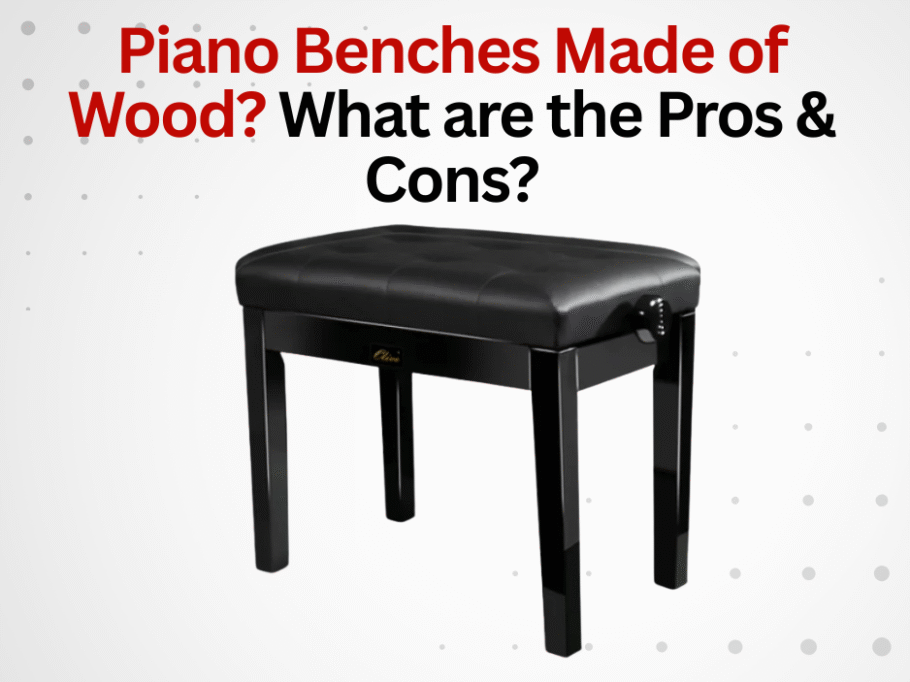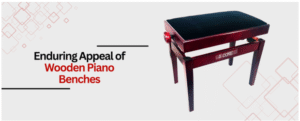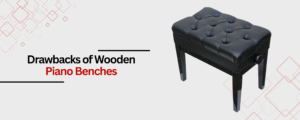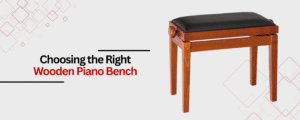Wooden piano benches have long been utilized in studios and concert halls due to their durability and classic appearance. However, their suitability for every pianist is not guaranteed, as both benefits and limitations are associated with their use. In this article, the key advantages and disadvantages of wooden piano benches will be examined to assist in making an informed decision.
The Enduring Appeal of Wooden Piano Benches
Wooden piano benches have been in use for many decades owing to their sturdy construction and timeless beauty. In various musical environments, their presence is common as they represent both tradition and practicality.
Durability and Stability:
A well-made wooden bench is known to last long. Hardwoods like oak, maple or walnut are commonly used which help provide stable seating platforms capable of enduring heavy use. The heavier weight combined with solid construction contributes to less mobility and more support which may assist with posture and technique.
Aesthetic Versatility:
Wooden benches are available in a numerous types of finishes and designs, making them suitable for blending with different interior styles. The professional and sophisticated look that comes with the natural grain of wood can be used in private and public performance spaces.
Comfort and Customization:
Many wooden benches come with padded seats, adjustable height mechanisms and storage compartments for sheet music or accessories. These features make it possible to customize the bench to meet individual needs, thus enhancing comfort during long hours of practice or playing.
Drawbacks of Wooden Piano Benches
Despite their advantages, wooden piano benches present certain limitations that must be considered.
Weight and Portability:
Solid wood benches are usually heavier than those made from metal or composite materials. This increased weight hampers portability such that frequent movements cannot be done practically.
Sensitivity to Environmental Factors:
Wood is subject to changes in temperature and humidity, which may result in warping, cracking, or loosening of joints over time. Regular maintenance, including dusting, polishing, and inspection for structural integrity, is necessary to preserve the bench’s condition.
Cost Considerations:
Benches made from high-quality wood typically incur higher costs compared to those made from alternative materials. While budget options are available, they may not provide the same durability, comfort, or finish as premium models.
Making the Right Choice
When choosing a good wooden piano bench one needs to make sure that it matches with their budget, for those prioritizing stability, long-term durability, and a classic look, wooden benches such as the 5 Core PNB 480 Piano Bench is often highly recommended. The 5 Core PNB 480 bench features a thick 3.25-inch padded cushion seat, multiple adjustable height options from 18 to 22 inches, and a robust combination of solid wood legs and a strong iron frame, supporting up to 235 lbs. Its ergonomic design, spill-resistant cover, and non-slip rubber feet make it suitable for home, studio, or stage environments, while easy assembly and a straightforward replacement policy add to its user-friendly appeal.
Other notable options include the K&M 14080 and Donner DKB-1, both recognized for their sturdy construction, adjustable features, and comfortable seating. Additionally, buyers may consider benches that offer enhanced comfort through premium padding, adjustable height mechanisms, and storage compartments, as these features can reduce fatigue, support healthy posture, and provide added convenience for performers of all ages and settings.
Searching for comfort and style? Explore our premium piano benches—ideal for both home practice and professional performance.
Don’t miss exclusive deals—upgrade to a high-quality piano bench for lasting support and elegance in your studio or on stage!
Practical Tips for Buyers
- Comfort Priority: For example padding and adjustable height are among key elements in order that will guarantee the long using of bench without any inconveniences.
- Quality Checking: It is necessary to pay attention on how the joints have been designed as well as what type of hardware has been used and overall construction quality
- Maintenance Planning: Without regular care such devices could fail anytime both in terms of operation and aesthetics.
Conclusion
In conclusion, wooden piano benches are known for their quality and durability. This has made them very popular among musicians. Some of the best models in the market include those from 5 Core, K&M, and Donner. They are not only strong and stable but also provide great comfort to the users. However, one should be prepared to carry a heavy bench when using a wooden one.
Ultimately, this decision rests with the pianist based on his or her needs as well as the venue where he or she will play. An investment in a piano bench must consider its features, materials used and long term usability. It is easy to make mistakes when making this choice by looking at just one feature instead of all of them holistically. A good bench would greatly contribute to both performance quality as well as comfort.




